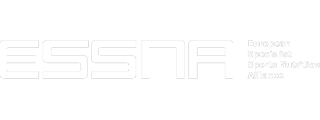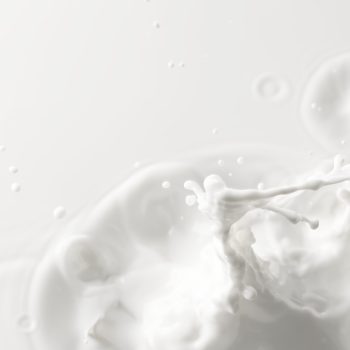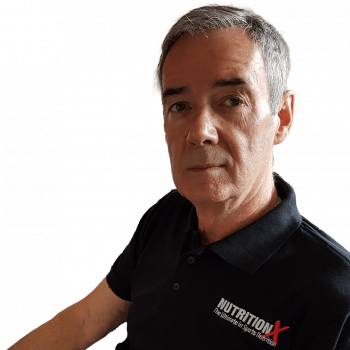At Nutrition X we believe in championing a food-first approach to nutrition - that's why our latest X-Change paper, written by Professor Don Maclaren, takes a detailed look at the nutritional benefits of milk and its impact on the athlete.
Read the full X-Change article here or download the PDF via the button below.
Practical Implications
- Bovine milk contains all of the essential nutrients needed for the growth and development of the young calf
- From a human perspective, bovine milk is an excellent source of nutrients such as protein and essential fatty acids, as well as many minerals and vitamins
- The protein content of bovine milk is such that it is an excellent base as a supplement for athletes, since it possesses a good span of essential amino acids
- Because of the high fluid content, bovine milk has been demonstrated to be a good source for rehydration after exercise
- Non-dairy (in effect vegetarian/vegan) milks are becoming more popular, although the scientific evidence for their efficacy (other than limited data on soy) is not yet available section deals with other types of milk
Introduction
Bovine milk contains the nutrients needed for growth and development of the calf, and is a sound resource of lipids, proteins, carbohydrate, vitamins and minerals. It contains immunoglobulins, hormones, growth factors, cytokines, nucleotides, peptides, polyamines, enzymes and other bioactive peptides. The carbohydrate source, lactose, and most minerals are in solution. Milk composition is dynamic, in so far as the composition varies with stage of lactation, age, breed, nutrition, energy balance and health status of the udder. The change in milk composition during the lactation period matches the changing need of the growing calf. Specific milk proteins are involved in the early development of immune response, whereas others take part in the non-immunological defence (eg. lactoferrin). Milk contains many different types of fatty acids, including essential fatty acids. All these components make milk a nutrient-rich food item.
Due to the composition of bovine milk, as well as the interest in nutritional supplements to aid sports performance, a number of investigations have been reported regarding the efficacy of milk per se. This article examines the nutritional contents of milk before exploring whether milk is likely to benefit athletes in training and competition. A brief final section deals with other types of milk.
Components of Bovine Milk
Nutrient components of milk
For centuries, humans have used milk from animals to drink and to produce foods such as cheese, and although there are slight variations in the components of food between animals, there is remarkable consistency. Figure 1 illustrates the essential components of bovine milk, and clearly demonstrates that the major constituents are water, lactose, fat, protein and minerals.
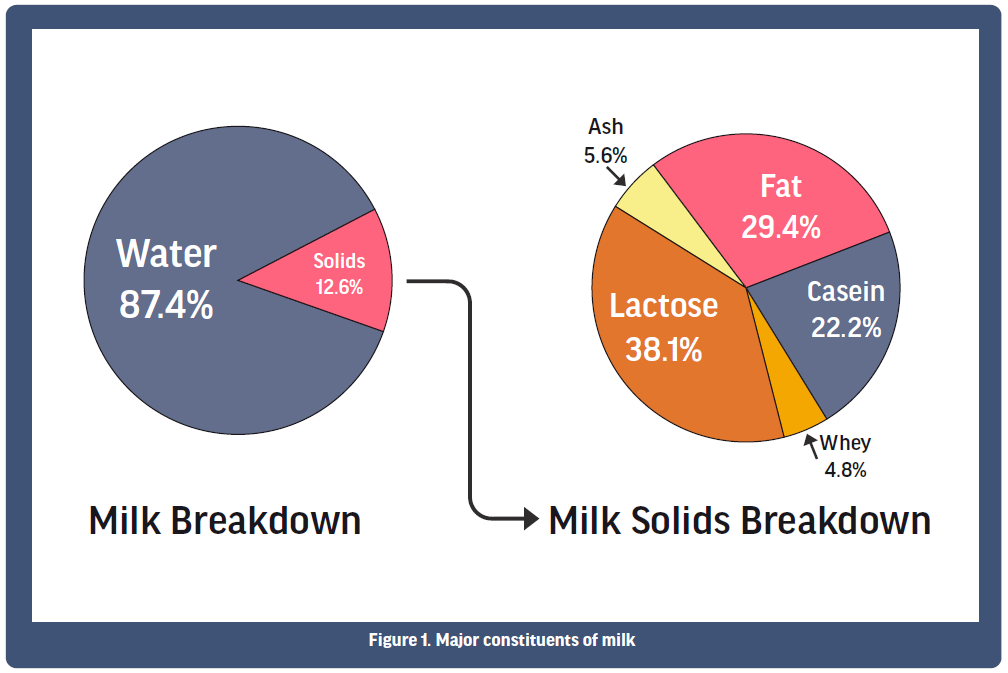
Milk contains about 38 g total lipid/l (see Table 1), whereby more than half of the milk fatty acids are saturated, accounting for ~20 g/l, whereas oleic acid is the single unsaturated fatty acid with the highest concentration in bovine milk accounting for ~10 g/litre. Bovine milk also contains about 32 g protein/l, in which the milk protein has a high biological value and is therefore a good source of essential amino acids. In fact, the protein content of milk is greater than that of human milk (Table 1). In addition, milk contains a wide array of proteins, with biological activities ranging from antimicrobial ones to those facilitating absorption of nutrients, as well as acting as growth factors, hormones, enzymes, antibodies and immune stimulants (Haug et al., 2007). The so-called milk proteins are in essence casein and whey, whereby the casein content of milk represents about 80% of milk proteins. The whey proteins are globular and are more water soluble than caseins, and the principal fractions are β-lactoglobulin, ɑ-lactalbumin, bovine serum albumin and immunoglobulins. Whey is the liquid remaining after milk has been curdled to produce cheese, and is used in many products for human consumption. The rate at which the amino acids are released during digestion and absorbed into the circulation may differ among the milk proteins, and whey proteins are considered as rapid digested protein that gives high concentrations of amino acids (notably leucine) in postprandial plasma (Tang et al., 2009). Milk is especially rich in essential amino acids and branched chain amino acids.
Table. 1 – Composition of human and bovine milk. Highlighted figures are significantly higher for that milk
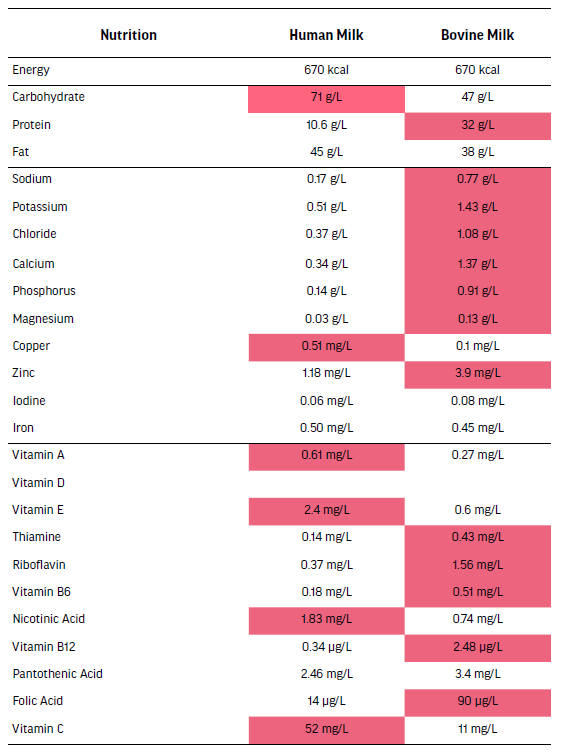
Daily consumption of ~1 litre of bovine milk supplies a significant amount of many of the nutrients that are required by humans. Milk components are crucial in metabolism in several ways, such as providing essential amino acids, vitamins, minerals and fatty acids, and by affecting absorption of nutrients. Milk fat is diverse with a wide-ranging spectrum of fatty acids and lipids, and many milk fat components have important roles in the body. Milk protein is especially rich in amino acids tha t stimulate muscle synthesis, and some proteins and peptides in milk also possess positive health effects. Content of several fatty acids, such as the ratio between omega-6 and omega-3 fatty acids are affected by the amount of grass and supplemental feeds (concentrate) in the diet. Milk content of several vitamins and minerals are also influenced by the cow's diet. Iodine and selenium are examples of trace elements that may be added to the feed, and thereby milk can be a good food source of these elements.
The protein components of milk are important for growth and development. Figure 2 highlights the constituents of whey and casein proteins found in milk, but also provide a visual idea as to the relative proportion of these two ‘milk proteins’.
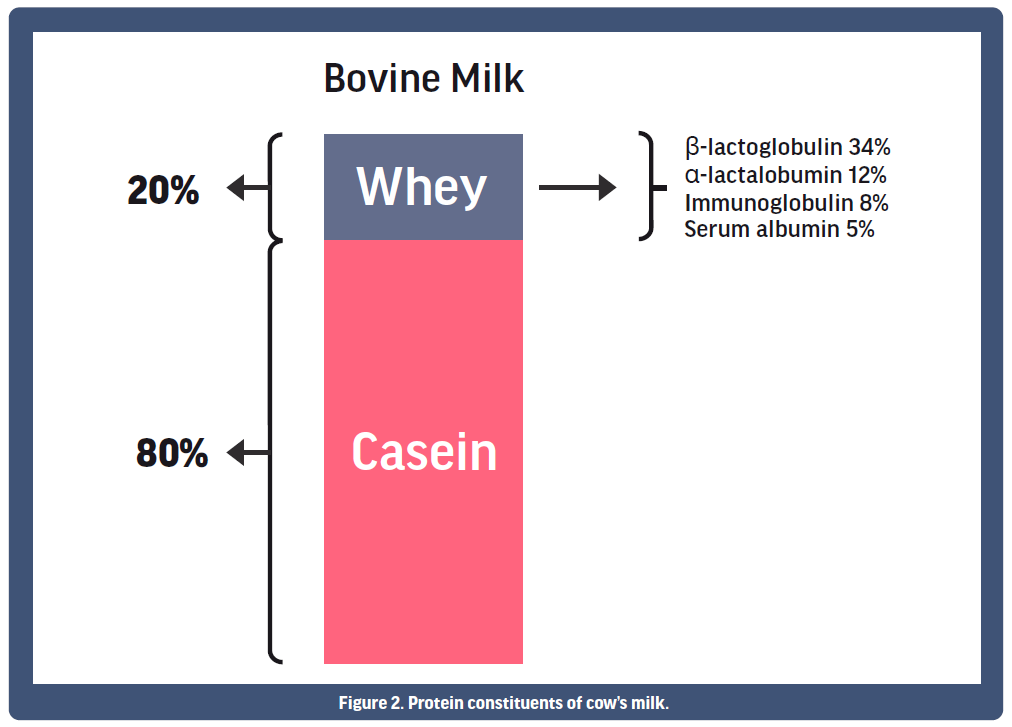
Ultracentrifugation of milk results in separating a sediment of the casein and a liquid top half (or supernatant) of whey which contains the water, lactose and soluble non-casein proteins. Once casein is removed, then, by definition, every other protein left in the milk preparation is a whey protein.
Whey contains about 50% of the nutrients present in milk – these include lactose, whey protein, minerals, a small amount of fat and most of the vitamins. You have already noted from Figure 1 the essential components of bovine milk. What is interesting to note is that most of these components (except for casein and much of the fat) can be found in the whey fraction. The nutrient composition of whey can be seen in Figure 3. Whey is a nutritious liquid containing whey proteins, lactose, vitamins and minerals, as well as enzymes, hormones, and growth factors. Figure 3 also highlights the nutrients present in whey in concentrations varying from grams per litre (outer ring) to nanograms per litre (core of rings).
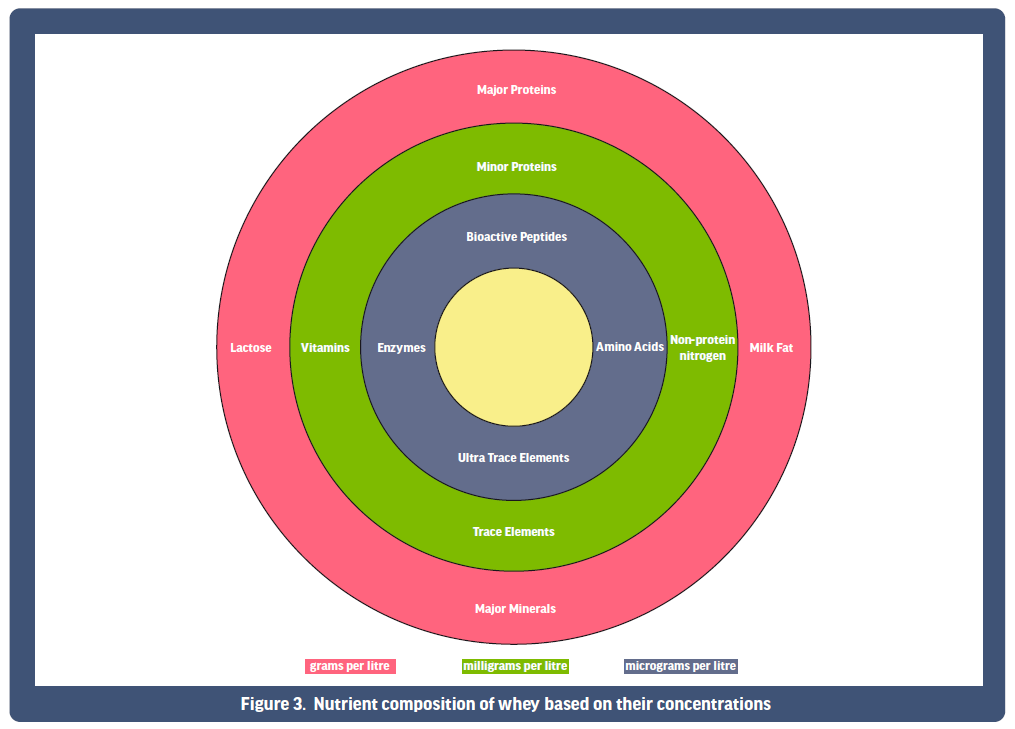
Since protein is important for the growth and development of young animals, the amino acid profile should contain sufficient amounts of the essential amino acids (EAAs). Table 2 highlights the amino acid profile of various protein sources, where it is clear that milk contains an impressive balance of the EAAs. Since the branched chain amino acids (BCAAs) are the key ‘drivers’ for protein synthesis in muscle, and that ~10g BCAAs would be ideal in one snack or meal, this could be supplied by drinking ~1 litre (or 1.75 pints) of milk alone. Supplementation of milk with additional protein or in conjunction with a protein-containing snack would reduce the requirement for milk intake yet achieve the same BCAA intake.
Grass vs forage fed cows and milk quality
Over the years there has been a debate about the quality of milk. Specifically, the concern regarding whether the cows producing the milk have been grazing on grass or on silage in sheds. It is suggested that milk from grass-fed cows is of a better quality than those fed on silage. But what does this mean? A major part of feed consumed by cattle consists of grass and other forage products. These products can vary dependent on the type of grass and also on other plants found in grass such as legumes (clover). Barley and wheat are the most widely used crops in the feeding of dairy cattle, but some farms also use oats. The ingestion and digestion of these various plant products have an impact on the quality of bovine milk. Since the plant material is affected by season and geography, the composition of dairy milk is affected by these factors. In this regard, cows are most likely to be found grazing on grass in the summer months and found indoors grazing on hay and other foods in winter periods – this is especially so in countries where there is a large variation in temperature between the two seasons such as in Northern Europe.
Numerous studies have investigated how bovine milk composition is influenced by the feed components. The fatty acid composition of milk, in particular, has received much attention, especially because of human health considerations. Also, fatty acids and other fat-soluble constituents and their metabolites influence milk flavour, as well as the texture and flavour of processed dairy products such as cheese and butter. Milk fatty acid composition is affected by feed components where higher contents of conjugated linoleic acid (CLA) have been related to the use of grass-based forage rather than maize silage, and to even higher proportions after eating clover and other legume species than grasses. Grazing of fresh pasture also gives higher concentrations of CLA in milk compared with conserved forage.
Several studies have examined the variation in milk fatty acid composition over a year. Generally, the content of CLA is significantly higher in summer months than in winter months, a variation that is ascribed to be an effect of pasturing. Antioxidant content in milk is also affected by feed composition: 2 to 6 times higher milk concentrations of carotenoids (vitamin A) as well as tocopherols (vitamin E) have been found when cows are fed grass silage instead of maize silage. Furthermore, the content of vitamin A in Danish organic milk is reported to be twice as high as the content in conventional milk. In commercial organic dairy products, 50% higher vitamin E and 80% higher vitamin A concentrations have been reported when compared with conventional products. In Sweden, higher concentrations of vitamins E and A have also been reported in summer milk compared with winter milk.
The fatty acids of bovine milk are derived from two sources. The first source is fatty acids supplied to the udder by the blood, and is composed of fatty acids absorbed from the intestine (and so that found in the food eaten) as well as that mobilized from the adipose fat tissue (also from diet). The second source is derived from circulating blood acetate and butyrate produced during fermentation in the rumen (known as de novo synthesis because it is new fatty acids being produced).
Milk contains relatively high levels of saturated fatty acids (more than 50% - 19g/litre from a total of about 33 g/litre), which may be of some concern regarding the links to raising cholesterol levels and increased risk of coronary heart disease. Also present is the monounsaturated fatty acid, oleic acid (about 8g/litre), and the polyunsaturated fatty acids omega-3 (about 1g/litre) and omega-6 (nearly 2 g/litre). These unsaturated fatty acids have great positive health benefits. Another fatty acid present in milk is that of conjugated linoleic acid (CLA).
Table. 2 – Amino acid profile of foods including milk
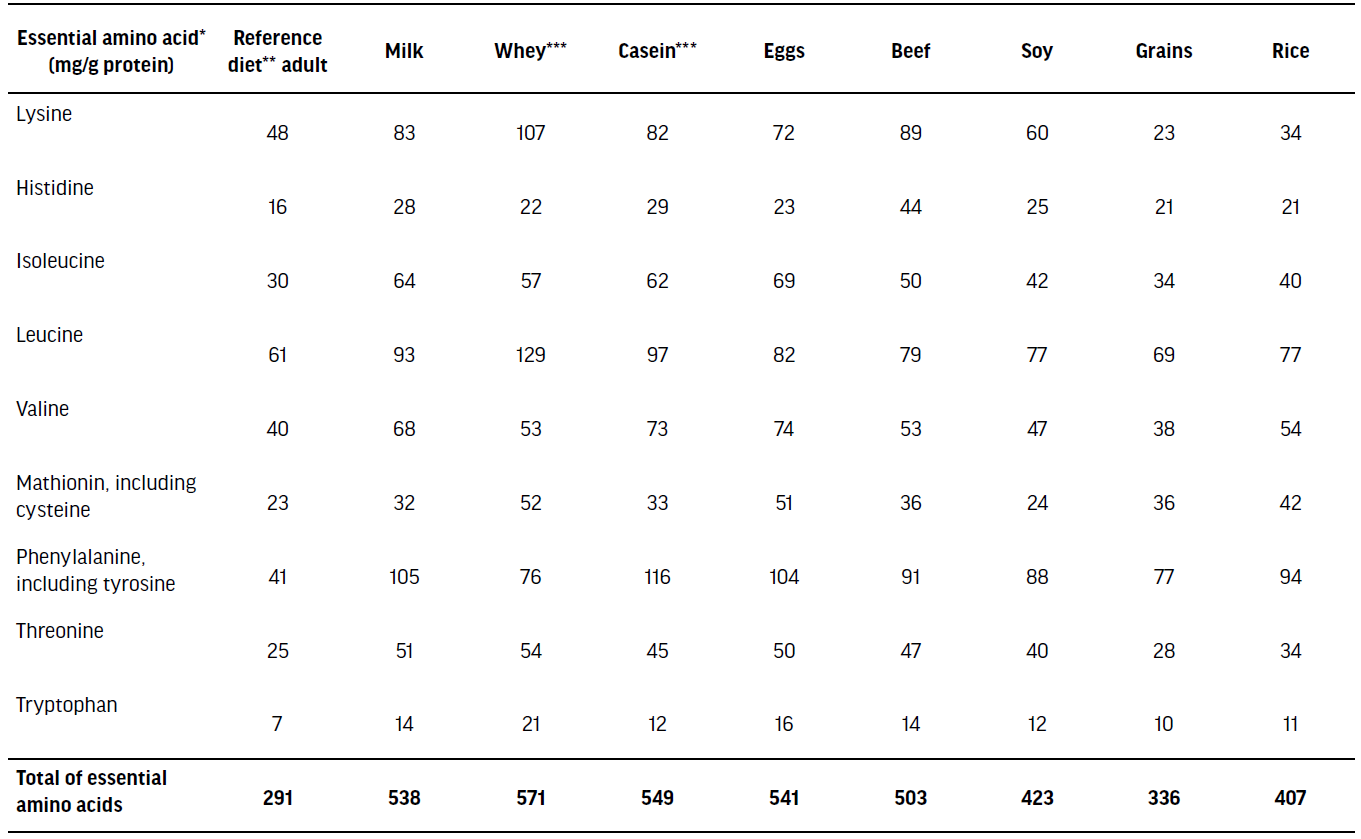
There are large variations in fat synthesis in the udder, and the fat content and fatty acid composition are the most modifiable of the main components in milk. There are seasonal variations for the major fatty acids. Milk from grazing dairy cows contains a significantly higher proportion of oleic acid than milk produced on traditional indoor feeding composed of concentrates and conserved roughages. Typically, CLA content in milk produced on pasture is at least twice of that obtained by indoor feeding. Moreover, the proportion of omega-3 fatty acid increases more than omega-6 fatty acid, resulting in a lower ratio between omega-6 and omega-3 fatty acids. Milk fat from cows fed an indoor diet consisting of conserved grass and concentrate have a ratio between omega-6 and omega-3 fatty acids of about 4:I, but in summer when the cows are out on pasture and have a high intake of grass the ratio may be reduced to about 2:l – and this is good . These positive effects of pasture on the fatty acid composition of milk are mainly attributed to the high content of polyunsaturated fatty acids, especially omega-3 fatty acid, in grasses at early stage of maturity.
In general, bovine milk protein content is relatively unresponsive to feeding factors. However, under most conditions, energy, but also protein supply, is a feed related factor with most pronounced effect on milk protein content. Milk protein content may be negatively influenced by high intake of dietary fat by the lactating cow. Thus, there may be a conflict between milk fatty acid composition and protein content. The feeding regime has only small impact on the proportion of the different types of milk proteins and consequently the amino acid composition.
Bovine milk contains a wide range of minerals (see Table 1). The calcium concentration in milk is relatively constant, with some variations throughout lactation. Most of the calcium is in the aqueous compartment and it is primarily associated with casein, and so the calcium concentration in milk is relatively constant because milk content of casein is unresponsive to feeding factors. Milk content of magnesium and zinc also show only small variations.
The concentration of selenium in bovine milk is related to selenium concentration in the feed, and there are great variations worldwide. In South Dakota the selenium concentration in milk is reported to be between 160 and 1300 ug/I, whereas the concentrations in milk from low-selenium regions may be from 5 to 30 ug/l as in Scandinavia and Northern Europe. A Swedish study showed that the average selenium concentration in milk was 14 ug/l and the concentration was more than doubled after supplementation with 3 mg selenium daily from selenium-enriched yeast.
As much as about 25 percent of the iodine intake may be excreted in milk. Therefore, milk content of iodine also varies depending on the iodine content and availability in the feeds used. A study on milk and milk products in Norway showed that milk from the summer season had significantly lower iodine concentration (88 ug/ l) compared with milk from the winter season (232 ug/l). This is explained by the use of more supplementary feeds enriched with iodine during the winter season. Dairy products supply much of the dietary intake of iodine.
The milk content of the fat-soluble vitamins A and E reflects their content in the feed since vitamins are not synthesised in the udder. In general, the content of these vitamins in feed plants are higher in fresh than conserved material. Consequently, there are regional and seasonal variations in these vitamins due to feeding regimes. For example, a study in Finland observed that the concentration of vitamin E in milk is 3-4 times higher during summer than in winter. Enriching the supplementary feeds with proper sources of these vitamins may increase the milk content during the winter season. All vitamins of the B-complex are synthesized by the rumen microbes, and so the milk content of B-vitamins are unrelated to their intake.
So, all in all, the effect of type of food ingested by cows has some impact on nutrient composition of milk. Whereas the protein and CHO as well as some minerals such as calcium remain unaffected by feeding, fatty acid composition and some micronutrients (selenium and iodine) are impacted by the quality of forage.
Milk and Exercise Performance
Endurance exercise
The primary limitations for the capacity to perform prolonged exercise are either muscle glycogen depletion or hypoglycaemia due to liver glycogen depletion (Malone et al., 2021). Additionally, the progressive loss of body fluids invariably leads to some level of dehydration and possible fatigue (Maughan & Shirreffs, 2004). The ingestion of exogenous CHO has been demonstrated to maintain circulating blood glucose concentrations and to aid muscle CHO oxidation (Malone et al., 2021). These factors appear to account for the increase in exercise capacity reported when CHO is ingested before and during prolonged exercise, although a direct or indirect effect on the central nervous system cannot be discounted. The ingestion of fluids also prolongs exercise time to exhaustion by maintaining blood volume (Montain & Coyle, 1992), with a concomitant reduction in cardiovascular and thermoregulatory strain (Sawka et al., 2001). Fluid and CHO ingestions improve exercise performance independently, and their effects appear to be additive (Below et al., 1995). Commercially available sports drinks are formulated to include CHO in concentrations of ~7%, typically in the form of glucose, sucrose, fructose and glucose polymers. Sports drinks also include varying concentrations of electrolytes, primarily sodium, to replace those lost in sweat, promote the intestinal absorption of glucose and water, and enhance post exercise rehydration.
Milk is a nutrient-dense food, containing CHO at a concentration that is similar to many commercially available sports drinks in addition to electrolytes and other micronutrients. It also contains protein, the addition of which may (Ivy et al., 2003) or may not (van Essen & Gibbala, 2006) influence exercise capacity. It could therefore be argued that low-fat milk, which has a low-fat content (typically 1 g/L), has the potential to prolong exercise capacity. Having said that, the presence of fat in whole milk is likely to slow gastric emptying without contributing as a useful energy source during exercise. The presence of lactose as the source of CHO may also limit milk’s efficacy when compared with alternative sources of CHO typically found in sports drinks, due to low rates of utilization and poor gastrointestinal tolerance when taken in large quantities. There exists little or no information on the effects of milk-based drinks on the response to prolonged exercise.
To address these issues, Lee et al. (2008) investigated the effects of ingesting either water, a CHO-electrolyte solution, 0.1% fat milk, or 0.1% fat milk with added glucose on exercise capacity, as well as the physiological and subjective responses to prolonged exercise to exhaustion. Data emanating from this study showed that the time to volitional exhaustion was not significantly influenced by the ingested drinks. Exercise capacity was 93.3 min, 110.6 min, 103.3 min, and 102.8 min for water, CHO-electrolyte, milk, and milk with glucose respectively, and when expressed as a percentage change in exercise capacity using the water trial as a baseline (0%), exercise times were longer by 17.5% (18.1 min) in the CHO-electrolyte trial and 10.4% (12.0 min) following milk ingestion.
However, it should be remembered that in addition to CHO, milk contains ~3.6% protein, primarily in the form of casein. Two laboratory-based studies have reported a significant increase in exercise time to exhaustion after the ingestion of CHO-protein solutions when compared with a CHO-only control (Ivy et al., 2003; Saunders et al., 2004). Ivy et al. (2003) provided cyclists with either a placebo or an ~7% CHO or ~7% CHO + protein drink during 3-h of cycling followed by a test to fatigue at 85% VO2max. The CHO and CHO+protein drinks significantly enhanced time to fatigue when compared with placebo (placebo – 12.7 min; CHO – 19.7 min; CHO+protein – 26.9 min). Saunders et al. (2004) also employed cycling performance, although in this investigation the cyclists rode at 75% VO2peak to fatigue followed ~12-h later by a further ride at 85% VO2peak. The time to fatigue in the first cycle bout was 29% longer (106.3 min) when consuming the CHO+protein drink than the CHO beverage (82.3 min), and 40% longer when consuming the CHO+protein (43.6 min) than when consuming the CHO (31.2 min) for the second ride. Taken together, these findings suggest that a CHO-protein drink is beneficial for endurance-based activities, although it must be noted that milk per se was not the choice of drinks in these two studies.
Tests of exercise capacity are not applicable to most sporting contexts, and so, with this in mind, adding approximately 2% protein to a carbohydrate sports drink to observe an increase in cycle endurance capacity compared with carbohydrate alone may be questionable. The practical implications of these studies are hampered by the performance test (exercise time to fatigue) not mimicking the way in which athletes typically compete (i.e., a race in which a fixed distance or set amount of work is performed as quickly as possible). Consequently, van Essen & Gibbala (2006) used an 80-km cycle time trial as their measure of performance (not capacity). Furthermore, participants ingested either a 6% CHO or 6% CHO with 2% protein drink or placebo every 15-min during the trial. Time to complete the time trial was 4.4% faster during CHO (135 min) and CHO+protein (135 min) compared with placebo (141 min), with no difference between CHO and CHO+protein.
In summary, milk is a nutrient-dense food, containing CHO at a concentration that is similar to many commercially available sports drinks, in addition to electrolytes and other micronutrients that may be beneficial to the sports performer. The results of these studies suggest that milk positively influences exercise capacity and performance when compared with the ingestion of plain water but not a CHO-electrolyte solution. One consideration to be aware however, is that there are reports of an increase in subjective feelings of stomach fullness late in exercise when milk is provided (Lee et al., 2006) even though there was no negative influence on exercise capacity.
Recovery from exercise
Fast and complete recovery from an exercise bout is important in so far as athletes need to be ready for subsequent bouts of training or competition. With this in mind, nutritional strategies to promote recovery have been investigated over the years. These have included recovery of muscle and liver glycogen stores, as well as muscle protein and muscle function. The likely benefits of ingesting milk have been a more recent development in research since earlier studies were mainly focused on either CHO to promote muscle and liver glycogen synthesis or protein/amino acid ingestion to enhance muscle protein synthesis.
It is undeniable that muscle and liver CHO stores are depleted to an extent during bouts of exercise and that these stores need replenishment in any recovery phase. To maximally stimulate glycogen synthesis, sport nutrition recommendations are to consume 1.2 g of CHO per kilogram body mass per hour for 4–6 h post exercise (Thomas et al., 2016). The addition of 0.3 g/kg body mass of a high-quality protein is also recommended to aid in post exercise recovery by stimulating muscle protein synthesis and repair (Thomas et al., 2016). Some evidence suggests that co-ingestion of CHO and protein after exercise may stimulate greater glycogen synthesis during recovery compared with carbohydrate (CHO) alone (Zawardzki et al., 1992)). This greater glycogen synthesis could be the result of increased insulin release from the pancreas from amino acids such as leucine. The net effect of a higher circulating insulin concentration is enhanced muscle glucose uptake when CHO and protein is consumed compared with CHO alone. It is also conceivable that consuming CHO and protein after exercise may promote glycogen synthesis to a greater extent than CHO alone by upregulating markers of glycogen synthase activity (Ivy et al., 2008).
A recent meta-analysis of the impact of protein with CHO for muscle glycogen resynthesis after exercise (Margolis et al., 2021) concluded that:
“post-exercise glycogen synthesis is enhanced by a higher energy intake when co-ingesting CHO-PRO compared with the same amount of CHO alone. Equally important is our observation that ingesting CHO-PRO did not impair muscle glycogen synthesis when compared with an isocaloric amount of CHO only. As such, we contend that matching the energy content provided in current sport nutrition recommendations for optimal glycogen recovery of 1.2 g/kg//h by lowering carbohydrate (0.9 g/kg/h) and adding back the equivalent amount of protein (0.3 g/kg//h) may yield the most complete post-exercise recovery by not only maximizing glycogen synthesis but also by stimulating muscle protein synthesis.”
If milk were to be the protein source for aiding muscle glycogen resynthesis, then drinking around 750ml/h would achieve the required 0.3g/kg/h of protein for an 80kg person. However, the CHO content of 750ml of bovine milk is ~32g and therefore only 0.4g/kg/h of CHO for an 80kg person – only 1/3 of the CHO requirement. Additional CHO would be needed. To date no study has been reported on actual milk consumption in relation to muscle glycogen resynthesis.
Exercise-induced muscle damage (EIMD) is commonly associated with activities involving eccentric muscle actions, and leads to the disruption of muscle structures thereby resulting in symptoms such as delayed-onset of muscle soreness (DOMS) and a likely concomitant decreased ability to produce force. DOMS and reduced force production can limit an athlete’s ability to train and perform. The use of protein–carbohydrate (CHO) supplements has been extensively studied but with equivocal findings. Those studies which have observed benefits have speculated that the results are due to the combination of carbohydrate and protein altering protein metabolism, which may limit the breakdown and/or increase the repair of muscle protein structures limiting myofibrillar disruption and the loss of cell membrane integrity (Tang et al., 2007). The net effect would be an increase in the availability of intramuscular protein and so limit decrements in muscle performance.
Cockburn et al. (2008; 2010; 2012) undertook a series of investigations demonstrating the efficacy of milk or milk-based protein after damaging exercise to attenuate EIMD. The first 2 studies provided participants with 1,000 mL of the supplement, equating to 34 g protein, 118 g CHO and 707 kcal for a milk-based protein–CHO supplement, and 34 g protein, 49 g CHO and 480 kcal in actual milk (Cockburn et al., 2008; 2010). Typically, they observed significant attenuation of EIMD and less of a decrease in muscle function when compared with placebo. The more recent study compared 1000ml with 500ml of milk, in which the findings were no significant difference between the higher and lower volumes of milk ingestion in attenuating EIMD or isokinetic muscle function (Cockburn et al., 2012).
These conclusions should not be surprising since other studies have shown that muscle protein synthesis reaches maximal stimulation after the consumption of 20 g high-quality intact protein, suggesting an upper limit for the incorporation of amino acids into proteins (Moore et al.,2009). Consuming protein in greater amounts than this leads to no further increase in protein synthesis since any additional amino acids are oxidised (in effect used as energy). Linking with the third study by Cockburn et al (2012) it could be hypothesised that is why consuming a smaller volume of CHO and protein (in 500mL) elicited similar effects with 1000mL. It could also be suggested that a lower volume of milk may be more practical for the athlete in terms of reduced caloric intake, and less stomach fullness and discomfort.
An interesting study which examined the efficacy of milk for stimulating muscle protein synthesis after resistance exercise rather than taking protein drinks per se proved positive (Elliot et al., 2006). Three groups of volunteers ingested one of three milk drinks each: 237 g of fat-free milk, 237 g of whole milk, and 393 g of fat-free milk isocaloric with the whole milk, and the milk was ingested 1-h following a leg resistance exercise routine. Blood concentrations of representative amino acids increased in response to milk ingestion as did glucose and insulin. The net result was that muscle protein synthesis was elevated with ingestion of the three milk drinks but most particularly with whole milk. It seems that milk not only provides the protein and key amino acids for delivery to muscle but also in stimulating insulin, provides a ‘driver’ for protein synthesis.
It seems that milk or milk-derived products are of benefit in recovery from exercise, be that in relation to glycogen resynthesis or factors associated with recovery from muscle damage. The net effect is that milk has potential in its own right as a useful supplement.
Effects on strength
Sarcopenia is an involuntary loss of muscle mass, strength and physical performance associated with aging, and it contributes to some adverse health outcomes. A study on a total of ~38,000 Korean adults (19-64yo) were examined to determine any relationships between milk consumption frequency (MCF), muscle mass and strength (Lee et al., 2020). The MCF was divided into two groups i.e. less than once per day, and greater than or equal to once per day. Muscle strength was measured using the hand-grip strength test, and a skeletal muscle index for assessment of muscle mass was also employed. Participants in the high MCF were significantly associated with a higher skeletal muscle index and a greater muscle strength than those in the lower MCF. The authors concluded that milk consumption could help prevent sarcopenia in adults.
In a smaller scale investigation observing the efficacy of chocolate milk and resistance training in older (~74yo) and younger (~24yo) males, the authors found no differences due to supplementation for strength or muscle fibre area after 12-weeks of training (Mitchell et al., 2015). Participants ingested either 500 mL of chocolate milk or placebo daily, immediately after the training session. Training increased strength in both age groups, but with no supplementation effect. Chocolate milk did not enhance skeletal muscle hypertrophy or strength following the training period. These results were rather similar to a previous 18-month study which explored the effects of fortified milk consumption in middle and old aged males for strength and muscle mass (Kukuljan et al., 2009). Their conclusion was that the daily consumption of fortified milk does not enhance the effects of resistance training on skeletal muscle size, strength, or function in healthy middle-aged and older men with adequate energy and nutrient intakes.
It is more likely that if milk is to bring about a difference in training response, the addition of protein to the milk may be necessary – particularly for older athletes where there is a greater protein requirement.
Rehydration
Other than recovery of CHO and protein stores following exercise, it should be remembered that dehydration also occurs due to body fluid losses via the sweat response. Therefore, rehydration of body fluids is also an important consideration. Some classic early studies from Maughan and Shirreffs (2004) described the key points in relation to rehydration following exercise. In these investigations the participants were firstly exercised on a cycle to reduce body mass by ~1.5% before drinking various volumes of fluid with varying concentrations of electrolytes after which levels of rehydration were assessed over a 4 to 6-h period (Shirreffs et al., 1996). The essential conclusions were that (a) a fluid volume (litres) of 1.5x the loss of body mass (kg) was needed eg. for a 1 kg loss of body mass a volume of 1.5L fluid should be consumed; (b) that addition of sodium was a driving force for levels of rehydration – in effect the greater concentration of Na+ the greater the retention of fluid in the body (although too much sodium could make the drink unpalatable); and (c) that addition of other nutrients (such as CHO or protein) did not affect rehydration.
With the above information in mind, and the fact that muscle protein recovery after exercise is important, some investigations have demonstrated that consumption of solutions containing protein after exercise-induced dehydration might confer an advantage in terms of fluid retention over protein-free solutions (Shirreffs et al., 2007; Watson et al., 2008). This may be as a consequence of an osmotic effect.
In fact, Shirreffs et al. (2007) demonstrated that low-fat milk, containing approximately 36 g/l protein, was retained better than either a CHO–electrolyte sports drink or water. They observed lowered cumulative urine output for milk (611 ml) and for milk with added Na+ (550 ml) compared to water (1184 ml) or a sports drink (1205 ml) – note the greater urine volume loss means less fluid retained in the body for hydration. Figure 4 highlights the net fluid balance (fluid ingested – fluid lost) over the 4-h time course for the 4 drinks. The authors also noted that participants remained in net positive fluid balance (euhydrated) throughout the recovery period after drinking the milk drinks but returned to net negative fluid balance 1-h after drinking the other drinks. The results of the study suggest that milk is an effective post-exercise rehydration drink and should be considered suitable for use after exercise except those who have lactose intolerance. Interestingly, examination of the contents of the drinks demonstrated that both milk-based drinks possessed higher Na+ concentrations than the sports drink; 38.6mM and 58mM for milk and milk with Na+ compared with 23mM for CHO-electrolyte drink.
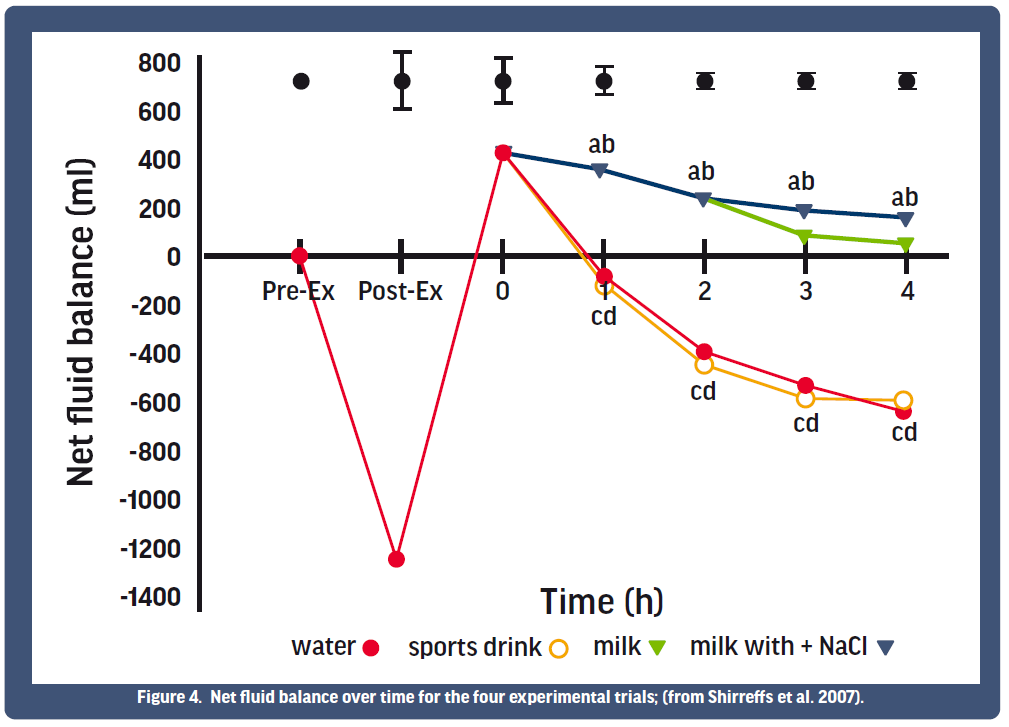
In a similar study, Watson et al. (2008) observed a tendency for increased fluid retention following the ingestion of low-fat milk compared with that of a CHO–electrolyte sports drink, and more recently Desbrow et al. (2014) found that milk-based drinks had a greater potential for rehydration than a CHO-electrolyte sports drink following exercise-induced dehydration. They calculated that the amount of fluid retained after 4-h rehydration with a milk-based meal supplement (Sustagen Sport) or bovine milk or soy milk or CHO-electrolyte drink (Powerade) were 65.1%, 40%, 46.9%, and 16.6% respectively. There were no significant differences between the milk-based products although the milk drinks were significantly better for rehydration than the CHO-electrolyte beverage.
To address the issue of variations in energy and electrolyte content, James et al. (2011) examined the specific effects of milk protein, rather than milk or a milk-based product, on rehydration after exercise in the heat. The authors compared an energy and electrolyte content-matched CHO with a CHO–milk protein solution consumed in a volume equivalent to 150% of body mass loss. The drinks contained 65 g/l CHO or a 40 g/l CHO with 25 g/l milk protein, both possessing small, but equivalent, amounts of sodium and potassium chloride. At the end of 4 hours recovery whole body net fluid balance was less negative for the CHO-protein-containing drink than the CHO only containing drink (Figure 5). The results of the study suggest that when matched for energy density and fat content, as well as for Na+ and K+ concentration, and when ingested after exercise-induced dehydration, the fluid retained within the body for a CHO–milk protein solution is greater than a CHO-only solution.
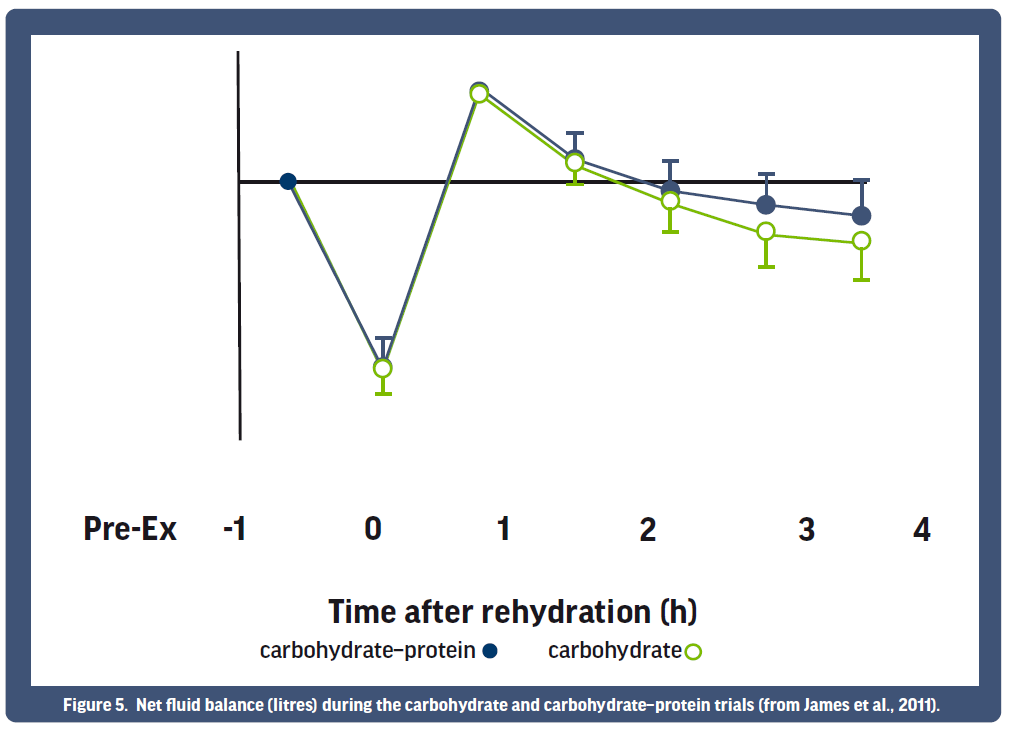
Table 3 - Nutritional content of whole (bovine) milk and non-dairy milks. (1 cup = 236mL or ~ 0.5 pint)
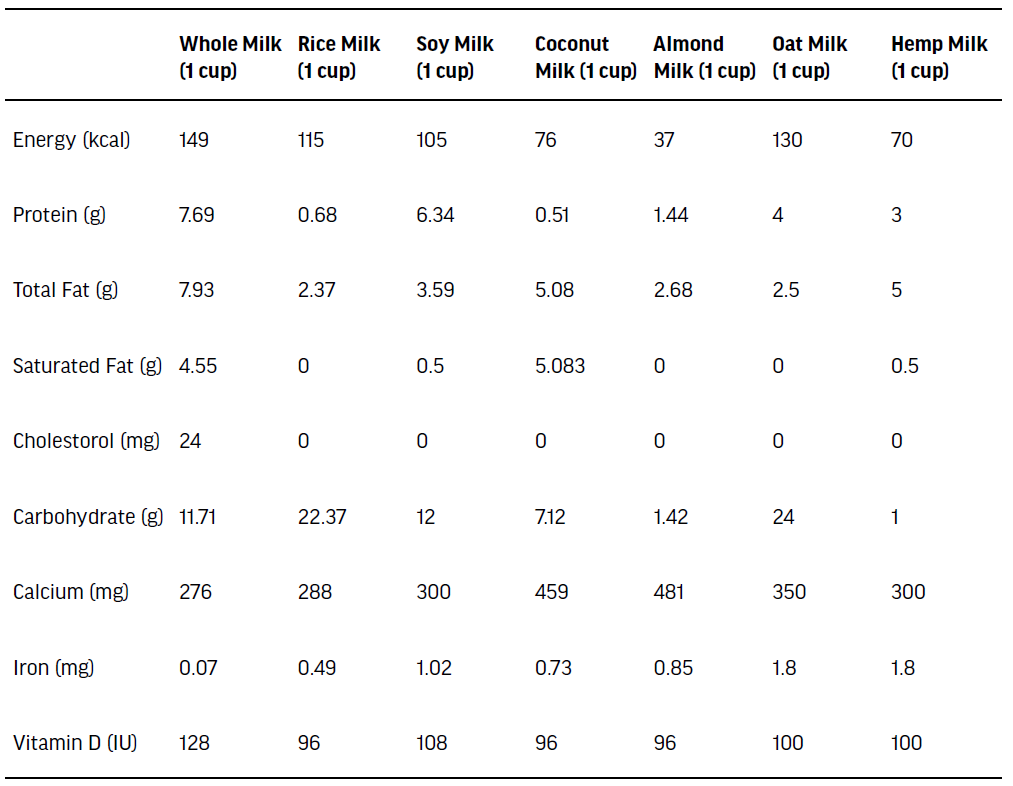
Other types of milk
So far, only studies concerning bovine milk have been presented. The fact that there are athletes who are vegetarian or vegan or lactose intolerant would eliminate their interest in consuming bovine milk and as a consequence other milk types may be more desirable. These milks include soy, almond, rice, coconut, oat, hemp, and so on. Table 3 highlights some of the key nutrients in various types of milk compared with whole (bovine) milk. It is quite evident that the protein contents of whole (bovine) milk and soy are significantly higher than the other sources, but that the CHO content is highest in rice and oat milks. This means that, other than soy, vegetable-derived milks are unlikely to be beneficial in aiding muscle recovery after exercise – at least from a protein synthesis perspective. On the other hand, rice and oat milks could be useful in helping CHO recovery. Of course, mixing soy with other forms of vegetable milks could, to some extent, overcome the issues with lack of protein.
Table 4 - Amino acid constituents of bovine and soy milks. Essential amino acids highlighted; branched chain amino acids (BCAAs are also essential).
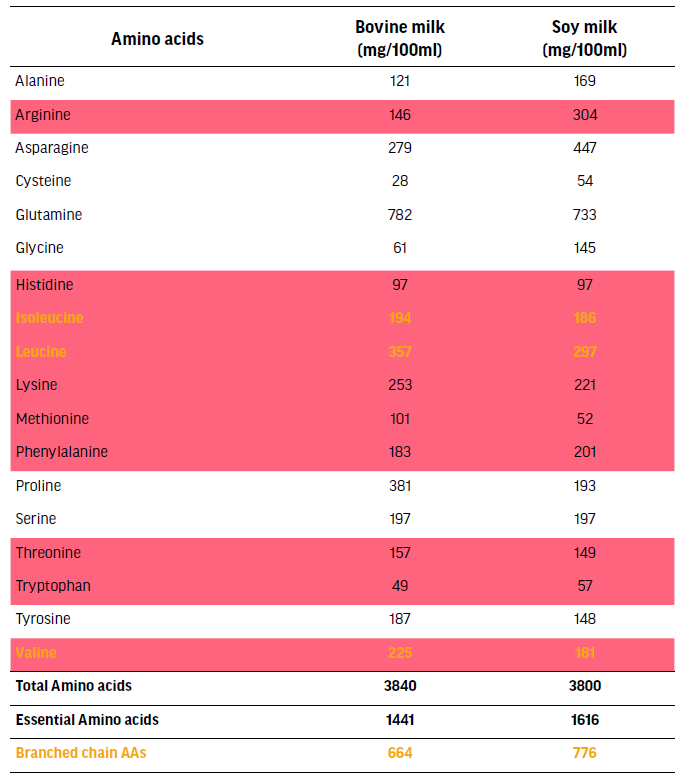
To date, there is no scientific evidence in regard to the likely efficacy of vegetarian-based milk products and exercise performance, although there is limited data for soy. It is beyond the scope of this article to provide a more detailed analysis of any findings in this respect and for a general understanding of likely benefits of plant-based milks it would be useful to consult Sethi et al. (2016). Having said that, soy proteins have been investigated in terms of muscle protein synthesis – usually compared with whey and casein from milk. The results from investigations on soy proteins (not soy milk per se) show some beneficial effects both with regard to stimulation of muscle protein synthesis after resistance exercise, although not as good as milk-based proteins (Hartman et al., 2007; Stark et al., 2012). The issue with soy vs bovine milk protein is in relation to the amino acid constituents. Table 4 clearly demonstrates that although the total amount of AAs in soy are as good as bovine milk, the key ‘drivers’ of muscle protein synthesis, the branched chain amino acids (notably leucine) are lower. Hence, soy milk is not as impressive as bovine milk for muscle recovery after exercise. On the other hand, soy milk is beneficial for post-exercise rehydration (Desbrow et al., 2014).
Conclusion
The composition of bovine milk with its nutrient composition of protein, lipids, carbohydrate and so on, together with the fact that it is a fluid, make it a sound potential supplement for athletes to consider. There is a plethora of evidence that the protein content of bovine milk alone aids muscle recovery after resistance exercise and stimulates protein synthesis. Additionally, since bovine milk is a fluid, there are significant rehydration capabilities. Indeed, bovine milk also has prospects as a supplement during prolonged exercise. Employing vegetarian-based milks for those who are lactose intolerant or are vegetarians/vegans should be considered. Although these types of milk, other than soy, are low in protein, they still possess rehydration potential. Furthermore, adding soy to almond or oat or rice milks increases the protein content of the milk, although (to date) there is no scientific evidence as to their efficacy.
References
- Cockburn E, Robson-Ansley P, Hayes PR, & Stevenson E. (2012). Effect of volume of milk consumed on the attenuation of exercise-induced muscle damage. European Journal of Applied Physiology, 112: 3187–3194.
- Cockburn E, Hayes PR, French DN, Stevenson E, St. Clair Gibson A (2008) Acute milk-based protein–CHO supplementation attenuates exercise-induced muscle damage. Applied Physiology Nutrition and Metabolism, 33: 775–783.
- Cockburn E, Stevenson E, Hayes PR, Robson-Ansley P, Howatson G (2010) Effect of milk-based carbohydrate–protein supplement timing on the attenuation of exercise-induced muscle damage. Applied Physiology Nutrition and Metabolism, 35: 270–277.
- Desbrow B, Jansen S, Barrett A, Leveritt MD, & Irwin C. (2014). Comparing the rehydration potential of different milk-based drinks to a carbohydrate–electrolyte beverage. Applied Physiology Nutrition & Metabolism, 39: 1366–1372.
- Elliot TA, Cree MG, Sanford AP, Wolfe RR, & Tipton KD. (2006). Milk ingestion stimulates net muscle protein synthesis following resistance exercise. Medicine and Science in Sports and Exercise, 38: 667–674.
- Hartman J, Tang J, Wilkinson S, Tarnopolsky M, Lawrence R, Fullerton A, & Phillips S. (2007). Consumption of fat-free fluid milk after resistance exercise promotes greater lean mass accretion than does consumption of soy or carbohydrate in young, novice, male weightlifters. American Journal of Clinical Nutrition, 86: 373–381.
- Haug A, Høstmark AT, & Harstad OM. (2007). Bovine milk in human nutrition – a review. Lipids in Health and Disease, 6: 25.
- Ivy JL, Ding Z, Hwang H, Cialdella-Kam LC, Morrison PJ. (2008). Post exercise carbohydrate-protein supplementation: phosphorylation of muscle proteins involved in glycogen synthesis and protein translation. Amino Acids, 35: 89–97.
- Ivy JL, Res PT, Sprague RC, & Widzer MO. (2003). Effect of a carbohydrate-protein supplement on endurance performance during exercise of varying intensity. International Journal of Sport Nutrition & Exercise Metabolism,13: 382–395.
- Kukuljan S, Nowson CA, Sanders K, & Daly RM. (2009). Effects of resistance exercise and fortified milk on skeletal muscle mass, muscle size, and functional performance in middle-aged and older men: an 18-mo randomized controlled trial. Journal of Applied Physiology, 107: 1864–1873.
- Lee J-H, Lee HS, Kim H, Kwon Y-J, & Lee JW. (2020). Association of milk consumption frequency on muscle mass and strength: an analysis of three representative Korean population studies. European Journal of Nutrition, 59: 3257–3267.
- Lee JKW, Maughan RJ, Shirreffs SM, & Watson P. (2008). Effects of milk ingestion on prolonged exercise capacity in young, healthy men. Nutrition, 24: 340–347.
- Malone JJ, Hulton AT, & MacLaren DPM (2021). Exogenous carbohydrate and regulation of muscle carbohydrate utilisation during exercise. European Journal of Applied Physiology, 121: 1255–1269.
- Margolis LM, Allen JT, Hatch-McChesney A, & Pasiakos SM. (2021). Coingestion of Carbohydrate and Protein on Muscle Glycogen Synthesis after Exercise: A Meta-analysis. Medicine and Science in Sports & Exercise, 53: 384–393.
- Maughan RJ, & Shirreffs SM. (2004). Rehydration and recovery after exercise. Science & Sports, 19: 234–238.
- Mitchell CJ, Oikawa SY, Ogborn DI, Nates NJ, MacNeil LG, Tarnopolsky M, & Phillips SM. (2015). Daily chocolate milk consumption does not enhance the effect of resistance training in young and old men: a randomized controlled trial. Applied Physiology Nutrition and Metabolism, 40: 199–202.
- Montain SJ, & Coyle EF. (1992). Influence of graded dehydration on hyperthermia and cardiovascular drift during exercise. Journal of Applied Physiology, 73:1340 –1350.
- Romano-Ely BC, Todd MK, Saunders MJ, & Laurent TS.(2006). Effect of an isocaloric carbohydrate-protein-antioxidant drink on cycling performance. Medicine and Science in Sports & Exercise, 38: 1608 –1616.
- Roy BD. (2008). Milk: the new sports drink? A Review. Journal of the International Society of Sports Nutrition, 5: 15.
- Sawka MN, Montain SJ, & Latzka WA. (2001). Hydration effects on thermoregulation and performance in the heat. Comparative Biochemistry Physiology: Molecular & Integrative Physiology, 128: 679 –690.
- Sethi S, Tyagi SK & Anurag RK. (2016). Plant-based milk alternatives an emerging segment of functional beverages: a review. Journal of Food Science Technology, 53: 3408–3423.
- Shirreffs, S.M., Taylor AJ, Leiper JB, & Maughan RJ. (1996). Postexercise rehydration in man: effects of volume consumed and drink sodium content. Medicine and Science in Sports & Exercise, 28:1260-1271.
- Stark M, Lukaszuk J, Prawitz A & Salacinski A. (2012). Protein timing and its effects on muscular hypertrophy and strength in individuals engaged in weight-training. Journal of the International Society of Sports Nutrition, 9: 54.
- Tang J.E., Moore D.R., Kujbida G.W., Tarnopolsky M.A., & Phillips S.M. (2009). Ingestion of whey hydrolysate, casein, or soy protein isolate: Effects on mixed muscle protein synthesis at rest and following resistance exercise in young men. Journal of Applied Physiology, 107: 987–992.
- Thomas DT, Erdman KA, & Burke LM. (2016). American College of Sports Medicine Joint Position Statement: nutrition and athletic performance. Medicine and Science in Sports & Exercise, 48: 543–546.
- van Essen M, & Gibala MJ. (2006). Failure of protein to improve time trial performance when added to a sports drink. Medicine and Science in Sports & Exercise, 38: 1476 – 1483.
- Watson, P., Love, T., Maughan, R., & Shirreffs, S. (2008). A comparison of the effects of milk and a carbohydrate-electrolyte drink on the restoration of fluid balance and exercise capacity in a hot, humid environment European Journal of Applied Physiology, 104: 633–642.
- Zawadzki KM, Yaspelkis BB III, & Ivy JL. (1992). Carbohydrate-protein complex increases the rate of muscle glycogen storage after exercise. Journal of Applied Physiology, 72: 1854 –1859.


